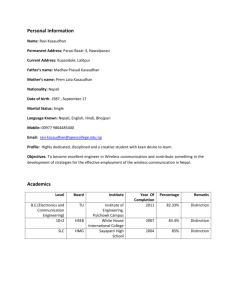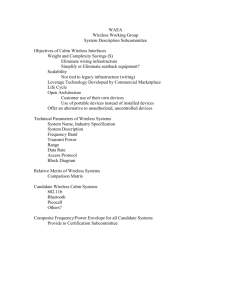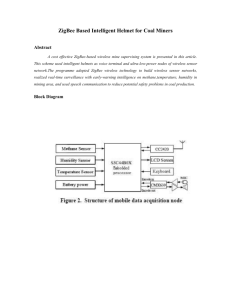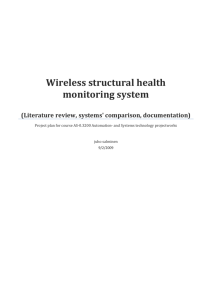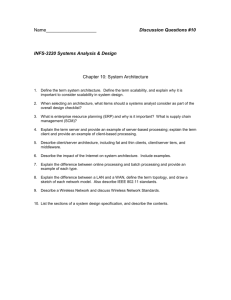Rural Access in Nepal using Wireless IP Technology
advertisement
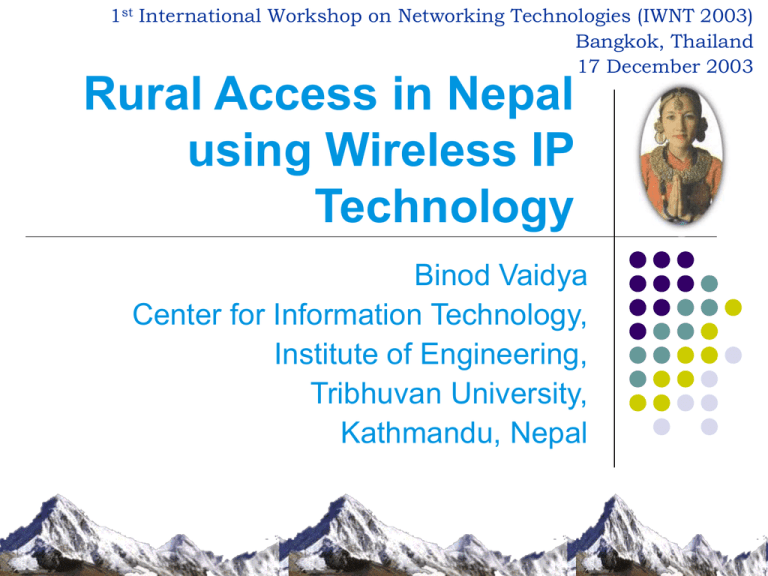
1st International Workshop on Networking Technologies (IWNT 2003) Bangkok, Thailand 17 December 2003 Rural Access in Nepal using Wireless IP Technology Binod Vaidya Center for Information Technology, Institute of Engineering, Tribhuvan University, Kathmandu, Nepal Introduction Nepal is located on southern slopes of midHimalayas between China and India. Ecologically, divided into Mountain, Hill and Terai (Plains), Administratively divided into 5 Development Regions, 14 Zones, 75 Districts and 3,914 Village Development Committees (VDC) Introduction Population of Nepal - 23.5 million About 84% still lives in rural areas. Most rural people are dependent on subsistence agriculture for livelihood. Overall literacy rate in Nepal For male - 58% For female - 22.8%. APT Project Title: Applicability of Data Mining Tools for forecasting prospects of e-technology integration at Multipurpose Community Telecenter (MCT) Objectives: To determine applicability of Data Mining Tools for forecasting Telecom based e-services and technologies for rural population. To determine feasibility of integration of above findings to the MCT. To compare findings with MCT in other countries of AsiaPacific Region, especially in South-East Asia. APT Project Implementing Organizations: Center for Information Technology, Institute of Engineering, Tribhuvan University Nepal Telecommunication Corporation Society of Electronics and Communication Engineers Nepal Funding Agency: Asia-Pacific Telecommunity (APT) Project Duration: 6 month (upto 2nd week of April) Selection of Districts for Survey Selection Criteria wider geographical diversity at least one district from each zone proportionate distribution in accordance with development regions, ecological regions, population distribution and literacy level easy access by road &/or by air Selection of Districts for Survey 35 districts districts for survey. 4 VDCs per district, 15 Households per VDC. elected person of VDC office. Operator of PCO (Public Call Office) if any. Districts selected Constraints for Rural Access in Nepal Physical isolation and difficult topographical conditions Underdeveloped physical infrastructure Low-income levels/ poverty Low population density Low level of computer education Little public awareness about internet and use of computer Absence of local content / language barrier to transfer information, with Nepali font not yet standardized Inadequate human resource development Lack of sufficient fund needed for huge investment in the ICT sector Access to Telecommunications NTC is still predominant operator for providing basic telephone and mobile services, United Telecom Ltd. (UTL) and STL ended NTC’s basic monopoly. Low telephone penetration Limited points of presence of ISPs About 1761 VDCs (45% of total VDCs) have access to telecommunication facilities. In 2002, telephone penetration : 1.61 main telephones lines per 100 inhabitants 0.09 cellular mobile subscribers per 1000 inhabitants. In rural areas only 1.64 telephone line per 1000 inhabitants Costly both backbone and last-mile connectivity Access to Computer and Internet facilities Low computer penetration - 0.35 PCs per 100 inhabitants in 2002. Internet services are only concentrated in major cities of Nepal In 2002, 0.67 Internet hosts per 10,000 inhabitants 26.39 Internet users per 10,000 inhabitants. Lack of appropriate bandwidth up to VDCs 38% of population living below income poverty line so cannot afford high costs associated with ICT services Access to Electricity Electricity supply reached to 40% of total population. Lack of reliable public Electricity supply In spite of its large hydropower potential, Nepal has produced about 548 MW of hydropower to date, supplies about 1.3% of total energy consumption. Although high potential in use of locally available renewable energy resources - solar, wind and microhydro, they are not widely used in Nepal. Choose of Appropriate Wireless Technology Wired networks cannot be used in remote and rural areas installation is too costly maintaining reliability is not cost effective. Need to adopt use of wireless technologies for Internet access. Using Wireless networks, remote areas of Nepal for: fast setup and implementation; Last-mile communications; movable installation; and mobility. Choose of Appropriate Wireless Technology Selecting wireless technology for settings requires thorough analysis of Geographical location remoteness from switching exchange, Application requirements for end users services for end users Anticipated traffic volume Capital and operational costs. rural Choice of Wireless Connectivity Rural connectivity has several requirements low-cost, low-power, robustness, scalability and ease of use. Some technology used for rural connectivity in Nepal are Radio Link - Microwave Wireless Local Loop (WLL), Very Small Aperture Terminal (VSAT) Wireless LAN/WAN IEEE 802.11 standard - most promising wireless technology. Wireless Fidelity (Wi-Fi) based on IEEE 802.11b standard widely used for indoor and outdoor environment. operates at 2.4GHz ISM band. Maximum speed of 11Mbps, Wireless LAN/WAN IEEE 802.11a standard uses OFDM in 5GHz bands can provide data rates up to 54Mbps IEEE 802.11g standard operates at 2.4GHz supports up to 22Mbps using OFDM. Wireless LAN/WAN Advantage of Wi-Fi network include: its ease of set-up, use, and maintenance; its relatively high bandwidth; its relatively low cost for both users and providers. Future Wireless access IEEE 802.16a standard – suitable for non-line-of-sight (NLOS) access. Operates in licensed and unlicensed frequencies between 2GHz and 11GHz using OFDM cover up to 30 miles of range With shared data rates up to 75 Mbps. IEEE 802.16a could be wireless backhaul technology to connect 802.11 WLANs. Considerations for Deploying Wi-Fi Technology Range and coverage Coverage area for typical Wi-Fi systems - ~ 10 km. With appropriate antennas and amplifiers, can achieve point-to-point connectivity at max. distance of 20 km. Security vulnerable to Intruders: Confidential information can be easily sniffed. Loss of data reliability and integrity may occur. Difficult to detect intrusion. IEEE 802.11 provides security via two methods: authentication (Open System or Shared Key) Encryption (WEP) Considerations for Deploying Wi-Fi Technology Interference and Coexistence RF interference still harassing WLAN deployments. RF sources such as codeless phones, microwave systems are culprit for Wi-Fi network Network Performance Factors that affect throughput include number of users, propagation factors such as range and multipath, type of WLAN system used, latency. Rural Digital Library Proposed Rural Digital Library (RDL) is Multi-purpose community telecenter (MCT) Partnerships will be Local Government authorities, NGOs, schools, and private organizations. Goal is to develop knowledge-based resource network with Internet access for isolated rural communities. RDL shall provide variety of services to different user groups in rural communities relating to: Formal and non-formal education; agriculture health; E-governance etc. Structure RDL network design will consist of Main Library Server Center (MLSC): Local Server Center (LSC): shall be located at public premise in DDC, will provide Internet access to all Local Server Centers through National backbone network. Will have main server shall be located at public premises in different neighboring VDCs. User Group (UG): may be located at public access facilities such as telecenters, schools, health centers, agricultural centers and government offices. Structure MLSC shall support 4 to 6 LSCs in concentrated clusters of communities located in the neighboring VDCs, Each LSC shall serve a number of (e.g. 3 to 10) User groups. Wireless Backhaul Link MLSC shall have point-to-point connectivity or point-tomultipoint connectivity via dedicated wireless IP links to LSCs that serve as wireless backhaul connection. On wireless backhaul link, access points to line can be used as hot spots Distribution node could be established to provide access to local community. With backbone nodes, distribution nodes are connected All wireless ISPs can be connected to MLSC to handle traffic from wireless ISP in LSCs and directing global traffic. Conclusion Due to sparsely distributed population in rural areas, it is economically viable to use wireless IP network Depending on appropriate low-cost antennae, wireless bridges, access points, Wi-Fi networks can be one of cost-effective options Rural Digital Library aims to respond to demand for ICT services to rural communities. Grid of Wi-Fi links between rural areas eventually connecting to the national infrastructure. Q&A Thank you bvaiya@ioe.edu.np
